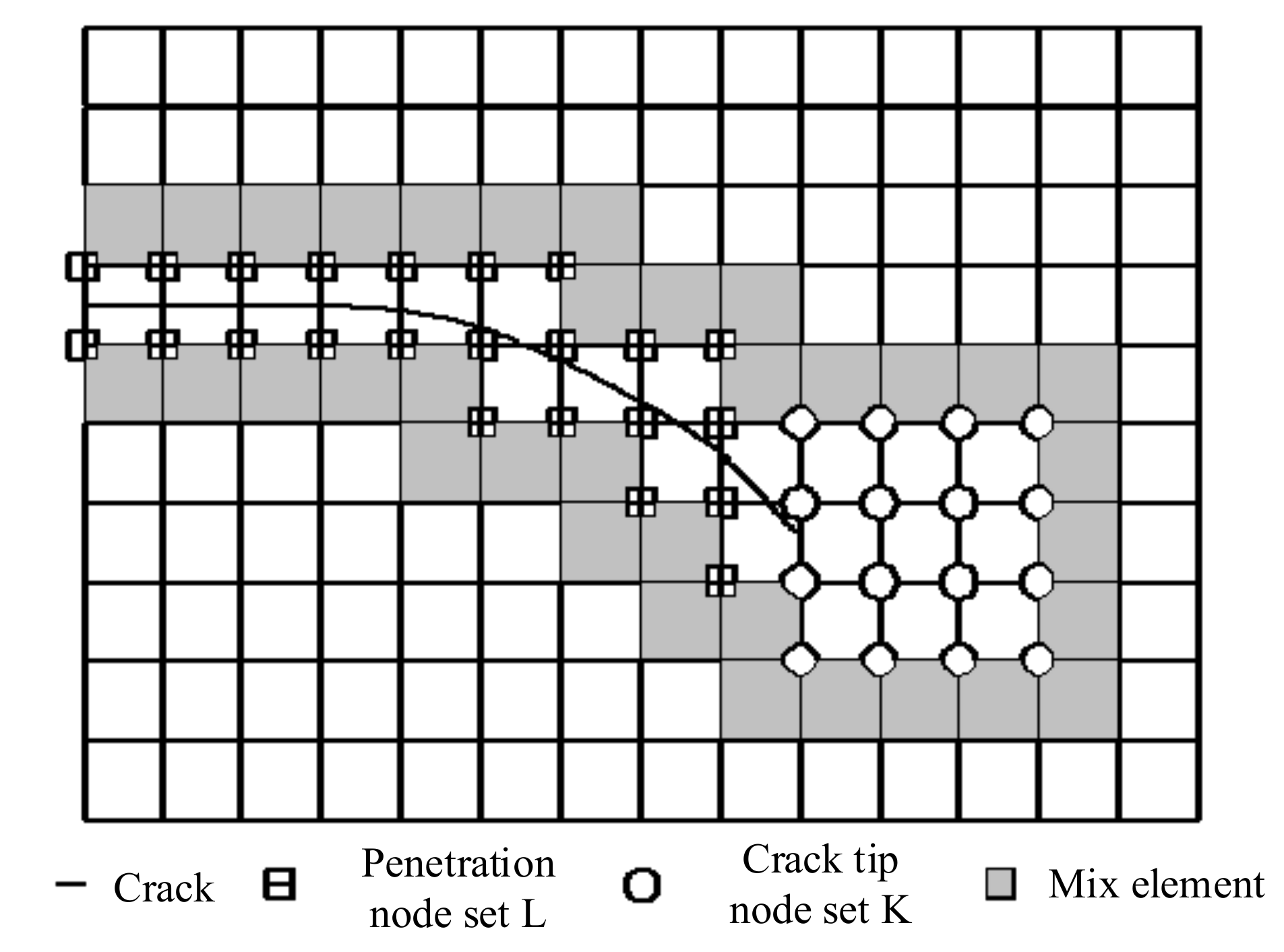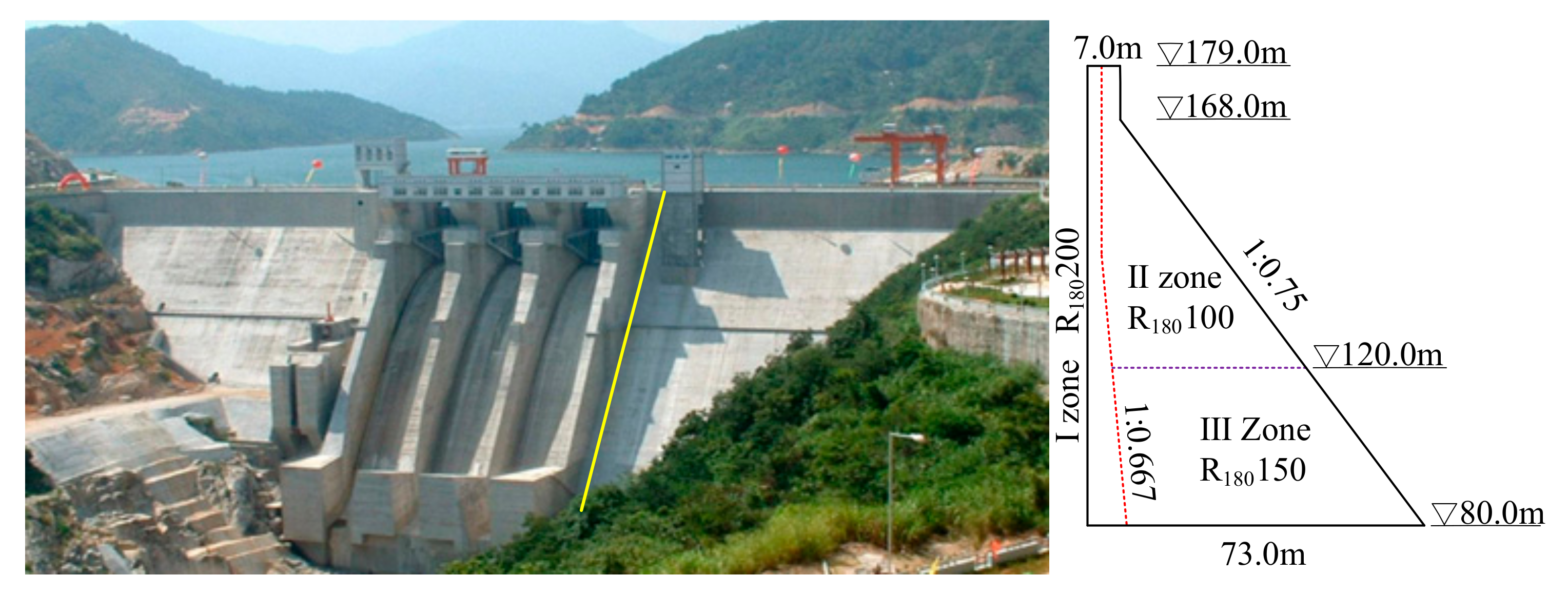Evaluation Method for Cohesive Crack Propagation in Fragile Locations of RCC Dam Using XFEM
Abstract
:1. Introduction
2. XFEM Description of the Strong Discontinuity
- (1)
- Crack penetration element:As the displacement field on both sides of the fracture surface jumps, the extended shape function [10] iswhere is the Heaviside function,The level set function [10] is:where is the element outside normal vector of the fracture at . For points not on the crack, is the shortest distance from to the crack. If the position of is consistent with the direction , take positive; conversely, take negative.
- (2)
- Crack-tip element:For elements around the crack tip, the extended shape function [10] iswhere is used to simulate the discontinuous displacement field at the crack tip. It is the basis of the Westergaard field at the asymptotic crack tip in the plane composite fracture of linear elastic fracture mechanics.
3. Propagation Simulation for the Cohesive Cracks
3.1. Governing Equation Derivation
3.2. XFEM Increment Discretization Simulation
4. Validation and Application
4.1. Validation by the Composite Cracking Simulation
4.2. Application on RCC Dam
4.2.1. XFEM Model and Material Parameters
4.2.2. Material Constitutive Relationships
4.2.3. Excess Water Level Method
4.2.4. Propagation Paths of the Interlayer Joints
4.2.5. Effects of the Interlayer Joint Propagation
5. Conclusions
- The established displacement function of the crack tip in the quadrilateral element and the geometric determination method of the crack-tip strengthening region were demonstrated to be more suitable for solving the cohesive cracks. The generalized Heaviside function used in the XFEM, similar to the exact local mode, could improve the adaptability of the displacement approximation function. Moreover, the adopted virtual node method could overcome the deficiency of distinguishing the type of inclined crack element by the level set.
- The computational results for the cohesive cracks through the XFEM increment discretization simulation were in agreement with the one-sided notched asymmetric four-point bending beam test results by Gálvez. In contrast to the modeling results by Cendón, the load–crack opening displacement curve and the crack development path in the loading stage were very similar. Hence, the proposed method simulating the cracking process without presupposing the crack path was proved to be feasible. The drawback is that a variable number of the freedom degrees per node are needed at the cohesive cracks in the presented method.
- The proposed methods were applied to simulate the cohesive crack propagation of the two typical weakest interlayer surfaces in the RCC gravity dam. In order to consider the influence of the plastic zone near the crack tip, the crack end was limited to the element edge and different models were used to simulate the constitutive relations. The localization caused by the softening of the crack surface could be simulated well by an overall average damage model. The gradual propagation and the morphology of the interlayer cracks obtained under the excess water level conditions indicate the crack approached the horizontal at the initial stage and inclined downward with the increase of the water head, which can make the dam deform downstream and rise.
Author Contributions
Funding
Data Availability Statement
Conflicts of Interest
Abbreviations
| RCC | Roller Compacted Concrete |
| XFEM | Extended Finite Element Method |
References
- Li, H.M. Analysis on and treatment of the cracks on the rolled concrete dam surface of the Fenhe reservoir two. Sci-Tech Inf. Dev. Econ. 2007, 17, 294–296. [Google Scholar]
- Zou, G.; Li, G.Z.; Wang, C.S.; Du, Z.D. Analysis on crack cause and treatment of horizontal winter construction joint. Water Conserv. Hydropower Technol. 1995, 8, 49–53. [Google Scholar]
- Qinami, A.; Bryant, E.C.; Sun, W.C.; Kaliske, M. Circumventing mesh bias by r- and h-adaptive techniques for variational eigenfracture. Int. J. Fract. 2019, 202, 129–142. [Google Scholar] [CrossRef]
- Sarrado, C.; Turon, A.; Costa, J.; Renart, J. On the validity of linear elastic fracture mechanics methods to measure the fracture toughness of adhesive joints. Int. J. Solids Struct. 2016, 81, 110–116. [Google Scholar] [CrossRef]
- Shimamoto, K.; Sekiguchi, Y.; Sato, C. Mixed mode fracture toughness of adhesively bonded joints with residual stress. Int. J. Solids Struct. 2016, 103, 120–126. [Google Scholar] [CrossRef]
- Kurumatani, M.; Soma, Y.; Terada, K. Simulations of cohesive fracture behavior of reinforced concrete by a fracture-mechanics-based damage model. Eng. Fract. Mech. 2019, 206, 392–407. [Google Scholar] [CrossRef]
- Zhang, Y.M.; Zhuang, X.Y. A softening-healing law for self-healing quasi-brittle materials: Analyzing with strong discontinuity embedded approach. Eng. Fract. Mech. 2018, 192, 290–306. [Google Scholar] [CrossRef] [Green Version]
- Rukavishnikov, V.A.; Mosolapov, A.O.; Rukavishnikova, E.I. Weighted finite element method for elasticity problem with a crack. Comput. Struct. 2021, 243, 106400. [Google Scholar] [CrossRef]
- Belytschko, T.; Black, T. Elastic crack growth in finite elements with minimal remeshing. Int. J. Numer. Methods Eng. 1999, 45, 601–620. [Google Scholar] [CrossRef]
- Moës, N.; Dolbow, J.; Belytschko, T. A finite element method for crack growth without remeshing. Int. J. Numer. Methods Eng. 1999, 45, 131–150. [Google Scholar] [CrossRef]
- Tran, T.D.; Le, C.V. Extended finite element method for plastic limit load computation of cracked structures. Int. J. Numer. Methods Eng. 2015, 104, 2–17. [Google Scholar] [CrossRef]
- Aghajanzadeh, S.M.; Mirzabozorg, H. Concrete fracture process modeling by combination of extended finite element method and smeared crack approach. Theor. Appl. Fract. Mech. 2019, 101, 306–319. [Google Scholar] [CrossRef]
- Surendran, M.; Natarajan, S.; Palani, G.S.; Bordas, S.P.A. Linear smoothed extended finite element method for fatigue crack growth simulations. Eng. Fract. Mech. 2019, 206, 551–564. [Google Scholar] [CrossRef]
- Kyoungsoo, P.; Paulino, G.H. Cohesive zone models: A critical review of traction-separation relationships across fracture surfaces. Appl. Mech. Rev. 2013, 64, 1–20. [Google Scholar]
- Moës, N.; Belytschko, T. Extended finite element method for cohesive crack growth. Eng. Fract. Mech. 2002, 69, 813–833. [Google Scholar] [CrossRef] [Green Version]
- Wolff, K.P.; Pitangueira, R.L.S.; Peixoto, R.G. A displacement-based and explicit non-planar 3D crack propagation model in the generalized/extended finite element method. Theor. Appl. Fract. Mech. 2020, 108, 102647. [Google Scholar] [CrossRef]
- Yan, Z.; Feng, W.J.; Zhang, C.; Liu, J.X. The extended finite element method with novel crack-tip enrichment functions for dynamic fracture analysis of interfacial cracks in piezoelectric–piezomagnetic bi-layered structures. Comput. Mech. 2019, 64, 1303–1319. [Google Scholar] [CrossRef]
- Remmers, J.J.C.; de Borst, R.; Needleman, A. A cohesive segments method for the simulation of crack growth. Comput. Mech. 2003, 31, 69–77. [Google Scholar] [CrossRef] [Green Version]
- Sanchez-Rivadeneira, A.G.; Duarte, C.A. A simple, first-order, well-conditioned, and optimally convergent Generalized/eXtended FEM for two- and three-dimensional linear elastic fracture mechanics. Comput. Methods Appl. Mech. Eng. 2020, 372, 113388. [Google Scholar] [CrossRef]
- Zhao, J.W.; Feng, S.Z.; Tao, Y.R.; Li, Z.X. Stable node-based smoothed extended finite element method for fracture analysis of structures. Comput. Struct. 2020, 240, 106357. [Google Scholar] [CrossRef]
- Jiang, S.Y.; Du, C.B. Study on dynamic interaction between crack and inclusion or void by using XFEM. Struct. Eng. Mech. 2017, 63, 329–345. [Google Scholar]
- Liu, W.H.; Zhang, L.W. A novel XFEM cohesive fracture framework for modeling nonlocal slip in randomly discrete fiber reinforced cementitious composites. Comput. Methods Appl. Mech. Eng. 2019, 355, 1026–1061. [Google Scholar] [CrossRef]
- Nguyen, N.V.; Lee, D.; Nguyen-Xuan, H.; Lee, J. A polygonal finite element approach for fatigue crack growth analysis of interfacial cracks. Theor. Appl. Fract. Mech. 2020, 108, 102576. [Google Scholar] [CrossRef]
- Alfano, G.; Marfia, S.; Sacco, E. A cohesive damage-friction interface model accounting for water pressure on crack propagation. Comput. Methods Appl. Mech. Eng. 2006, 196, 192–209. [Google Scholar] [CrossRef]
- Zhang, S.R.; Wang, G.H.; Yu, X.R. Seismic cracking analysis of concrete gravity dams with initial cracks using the extended finite element method. Eng. Struct. 2013, 56, 528–543. [Google Scholar] [CrossRef]
- Jiang, S.Y.; Du, C.B. Coupled finite volume methods and extended finite element methods for the dynamic crack propagation modelling with the pressurized crack surfaces. Shock. Vib. 2017, 3751340. [Google Scholar] [CrossRef] [Green Version]
- Zhao, K.K.; Jiang, P.F.; Feng, Y.J.; Sun, X.D.; Cheng, L.X.; Zheng, J.W. Numerical investigation of hydraulic fracture propagation in naturally fractured reservoirs based on lattice spring model. Geofluids 2020, 2020, 8845990. [Google Scholar] [CrossRef]
- Haghani, M.; Neya, B.N.; Ahmadi, M.T.; Amiri, J.V. Combining XFEM and time integration by alpha-method for seismic analysis of dam-foundation-reservoir. Theor. Appl. Fract. Mech. 2020, 109, 102752. [Google Scholar] [CrossRef]
- Martínez-Pañeda, E.; Natarajan, S.; Bordas, S. Gradient plasticity crack tip characterization by means of the extended finite element method. Comput. Mech. 2017, 59, 831–842. [Google Scholar] [CrossRef] [Green Version]
- Huan, S.L.; Kee, B.Y. Estimation of C(t) and the creep crack tip stress field of functionally graded materials and verification via finite element analysis. Compos. Struct. 2016, 153, 728–737. [Google Scholar]
- Stolarska, M.; Chopp, D.L.; Moës, N.; Belytschko, T. Modelling crack growth by level sets in the extended finite element method. Int. J. Numer. Methods Eng. 2001, 51, 943–960. [Google Scholar] [CrossRef]
- Montoya, A.; Ramirez-Tamayo, D.; Millwater, H.; Kirby, M. A complex-variable virtual crack extension finite element method for elastic-plastic fracture mechanics. Eng. Fract. Mech. 2018, 202, 242–258. [Google Scholar] [CrossRef]
- Gálvez, J.C.; Elices, M.; Guinea, G.V.; Planas, J. Mixed mode fracture of concrete under proportional and nonproportional loading. Int. J. Fract. 1998, 94, 267–284. [Google Scholar] [CrossRef]
- Cendón, D.A.; Gálvez, J.C.; Elices, M.; Planas, J. Modeling the fracture of concrete under mixed loading. Int. J. Fract. 2000, 103, 293–310. [Google Scholar] [CrossRef]
- Li, Q.X.; Dong, Q.J.; Mao, Y.Q. Design of RCC gravity dam of Mianhuatan hydropower station. Water Power 2001, 7, 24–27. [Google Scholar]
- Wang, S.C.; Chen, H.C. RCC dam construction of Mianhuatan hydropower station. Water Power 2001, 7, 41–44. [Google Scholar]
- Zhang, C.H.; Wang, G.L.; Wang, S.M.; Dong, Y.X. Experimental tests of rolled compacted concrete and nonlinear fracture analysis of rolled compacted concrete dams. J. Mater. Civil. Eng. 2002, 14, 108–115. [Google Scholar]
- Sheng, M.; Li, G.S. Extended finite element modeling of hydraulic fracture propagation. Eng. Mech. 2014, 31, 123–128. [Google Scholar]





















| Material | Elastic Modulus (GPa) | Poisson Ratio | Tension Strength (MPa) | Compression Strength (MPa) | Friction Angle (°) | Density (kg/m3) |
|---|---|---|---|---|---|---|
| Concrete | I 28.4; II 28.2; III 26.7 | 0.167 | 1.5 | 13.4 | 48.5 | 2400 |
| Rock mass | 16 | 0.2 | 1.0 | / | / | 2700 |
| Total Length of the Interlayer Crack (m) | Horizontal Deformation (mm) | Vertical Deformation (mm) | Shear Displacement (mm) | Opening Displacement (mm) |
|---|---|---|---|---|
| 2.000 | 0.000 | 0.000 | 0.000 | 0.647 |
| 3.000 | 5.750 | 0.629 | 0.403 | 0.658 |
| 4.300 | 6.723 | 0.835 | 0.695 | 0.973 |
| 5.650 | 6.872 | 0.893 | 0.772 | 1.059 |
| 6.520 | 6.937 | 0.917 | 0.819 | 1.090 |
| 7.600 | 7.167 | 1.004 | 0.949 | 1.207 |
| 8.860 | 8.282 | 1.282 | 1.226 | 1.566 |
| 9.730 | 8.333 | 1.300 | 1.264 | 1.583 |
| 10.080 | 8.802 | 1.432 | 1.384 | 1.748 |
| 11.170 | 9.227 | 1.521 | 1.486 | 1.851 |
| 12.600 | 11.081 | 1.922 | 1.898 | 2.333 |
Publisher’s Note: MDPI stays neutral with regard to jurisdictional claims in published maps and institutional affiliations. |
© 2020 by the authors. Licensee MDPI, Basel, Switzerland. This article is an open access article distributed under the terms and conditions of the Creative Commons Attribution (CC BY) license (http://creativecommons.org/licenses/by/4.0/).
Share and Cite
Zhao, E.; Li, B. Evaluation Method for Cohesive Crack Propagation in Fragile Locations of RCC Dam Using XFEM. Water 2021, 13, 58. https://doi.org/10.3390/w13010058
Zhao E, Li B. Evaluation Method for Cohesive Crack Propagation in Fragile Locations of RCC Dam Using XFEM. Water. 2021; 13(1):58. https://doi.org/10.3390/w13010058
Chicago/Turabian StyleZhao, Erfeng, and Bo Li. 2021. "Evaluation Method for Cohesive Crack Propagation in Fragile Locations of RCC Dam Using XFEM" Water 13, no. 1: 58. https://doi.org/10.3390/w13010058






